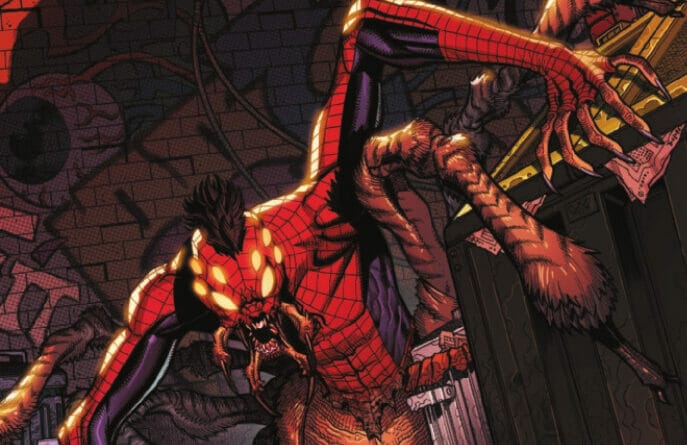Spoilers Ahead For Savage Spider-Man #2
Following on from the ‘Non-Stop Spider-Man’ series, Peter Parker has tracked down Zemo and the cabal known as the Immacultam. Immacultam has concocted a new drug called A-Plus, which provides users with a brief period of improved performance before zapping them of their intelligence. The leader of this cabal, a man named Wülf, has injected Spider-Man with this drug and dumped him and Baron Zemo onto a monster-riddled tropical island.
Unfortunately for Spider-Man, and Zemo, the A-Plus drug has combined horribly with his spider physiology, morphing our hero into a monstrous version of himself. Spider-Man has gained dominance over his fellow monstrous victims and organized a tribe with one goal: Kill Zemo. Writer Joe Kelly, penciler Gerardo Sandoval, color artist Chris Sotomayor, and letter VC’s Travis Lanham work together on this issue to showcase Peter Parker’s shift from the friendly neighborhood to the terrifying jungle.
However, it seems the balance of power on this isle of monsters may shift once more as Zemo’s forces arrive to back him up. Meanwhile, the Immacultam has initiated its plans for global genetic purity. Savage Spider-Man Issue Two sets the stage for a high-stakes battle that Spider-Man, in whatever form, will be forced to overcome.
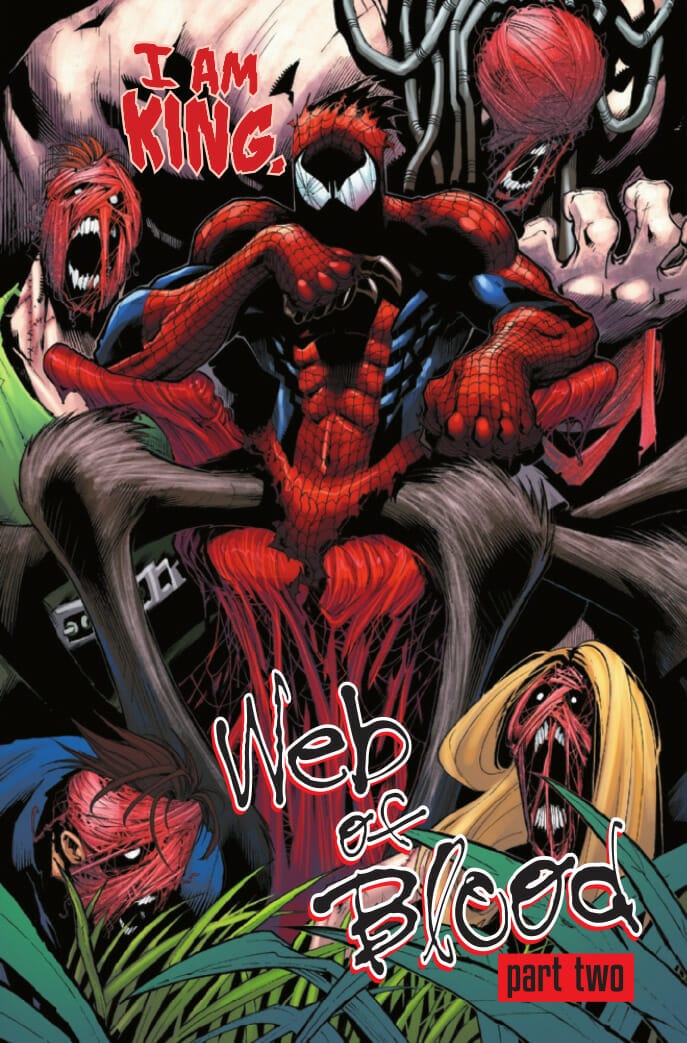
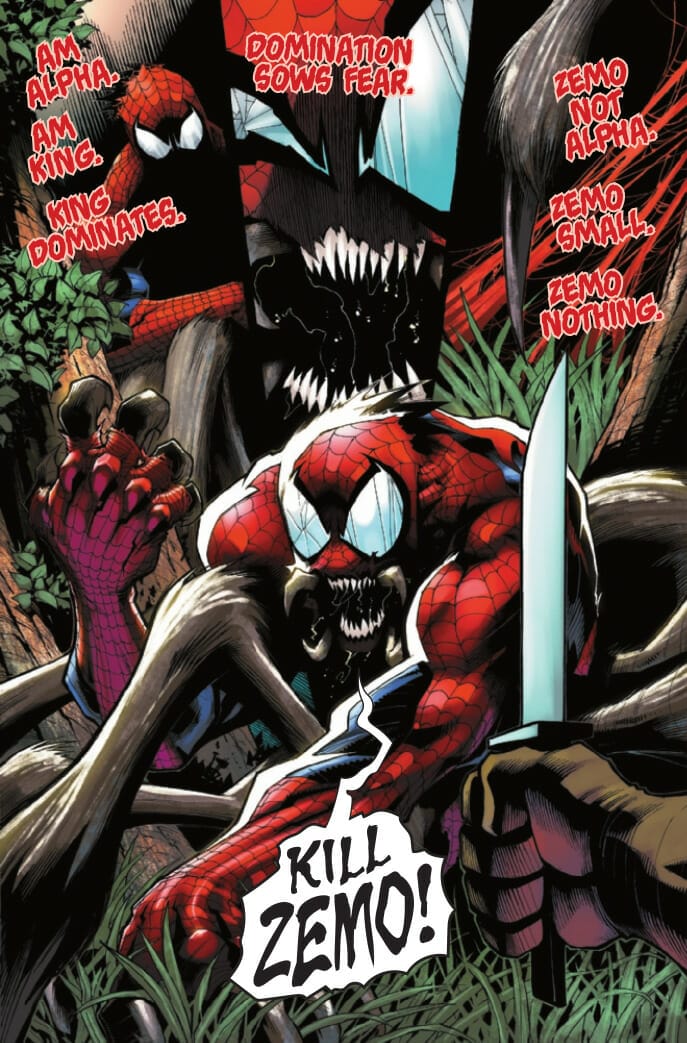
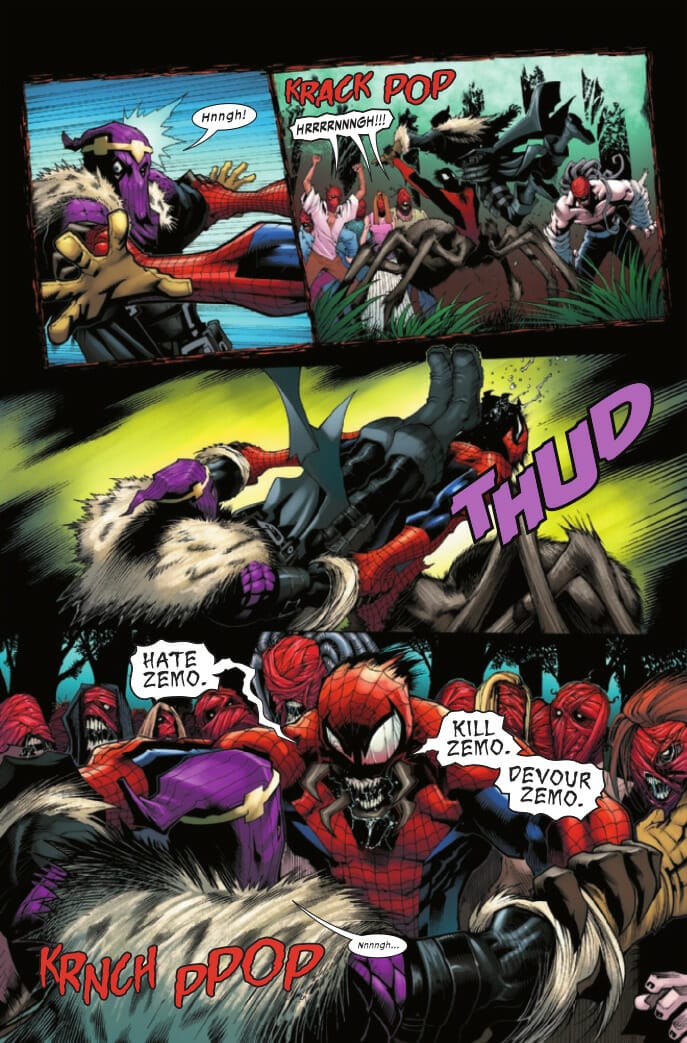
To Begin, many fans of the Spider-Man books from the ’90s may recognize a resemblance between the design of the ‘Savage Spider-Man’ and the character of doppelganger. Well, it seems since this book’s inception the creative team has been aware of these similarities in appearance as Sandoval’s pencils carry a distinct 90s flavor with them.
Characters within the series are drawing with extreme versions of their traditional proportions. Facial features are distinct, bigger, more vibrant and their musculature is jagged and sharp. The use of a more exaggerated style, although polarising for some in regard to character design, allows for a much more expressive and intriguing visual experience.
The action set pieces are presented in a more dynamic way due to how clearly the reader can perceive movement and expressions. An extreme take on anatomy works especially well for characters such as Spider-Man, due to the extra emphasis placed on his facial expressions throughout his stories. This emphasis on expressions still holds true here, Spidey’s eyes are constantly changing and in a rather violent manner, allowing the turbulent nature of this new monstrous version of Spider-Man to shine through.
Sandoval’s style further lends itself to the Savage Spider-man books due to how his style allows the silhouettes of the characters to stand out. As previously stated, this factor allows the reader to perceive a character’s movements much easier. Another benefit of Sandoval’s pencils having a distinct sense of anatomy is that they ensure that Spider-Man can smoothly move into the wild and acrobatic poses that have become a staple of his character.
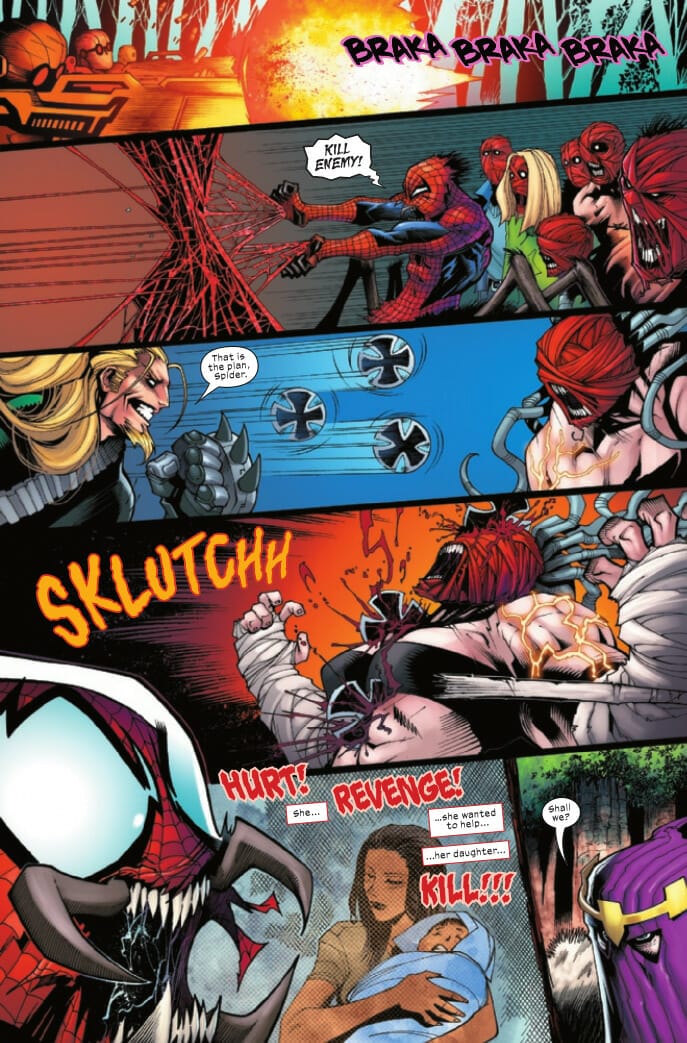
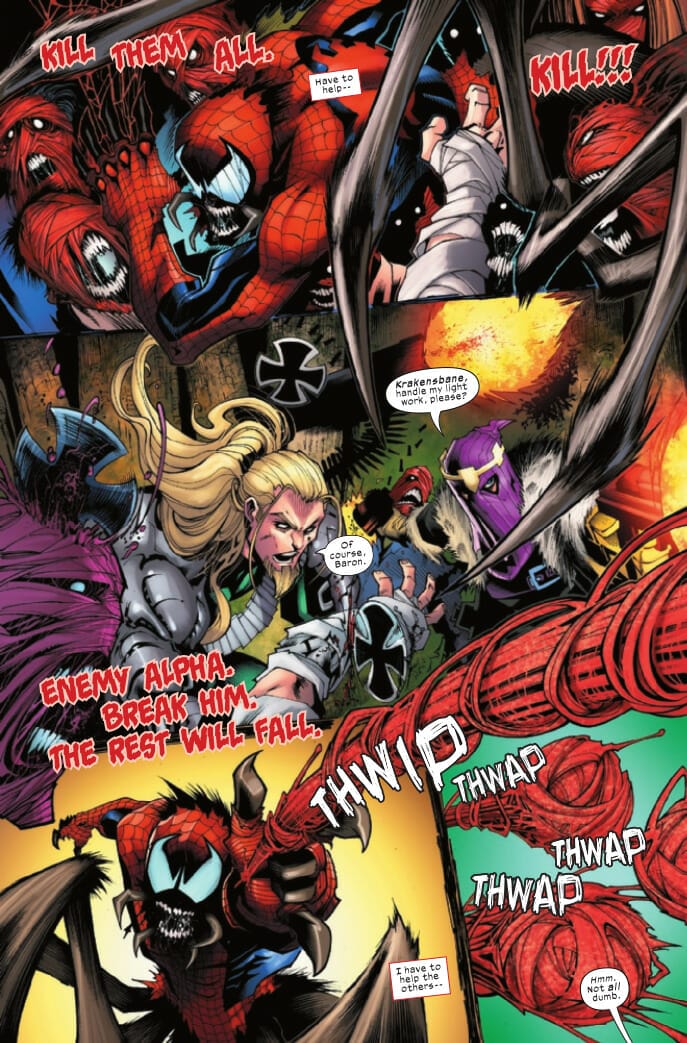
A strange creative choice made within the issue is the use of a large number of splash pages. Whilst the visuals on these pages provide a greater sense of fluidity and are more dynamic, the appearance of several splash pages in a row is rather distracting, creating a difficult reading experience. The presence of so many splash pages throughout the issue will stunt the visuals on the single pages in between.
In contrast to the wide display offered by these double-page spreads, the imagery on the single pages often appears to be cropped in some sense; certain actions or body parts are cut off due to space limitations, therefore halting the flow of the issue. A severe separation can be felt between the stagnant nature of the single pages and the fluent imagery of the splash pages.
The majority of the issue is taken up by the battle between Savage Spider-Man’s tribe of monsters and Zemo’s armed forces, and therefore the minimal exposition throughout the issue is given little time to flesh out any major ideas. Whilst there are more issues available for major plot points to be expanded upon, placing an emphasis on action for one issue and then exposition for another may affect the narrative flow, affecting the balance of the reading experience.
For example, although the previous issue had a rather large emphasis on the fight between Spider-Man and Zemo, it still offered moments of calm in which the book could explore the inner workings of the Savage Spider-Man and his internal dialogue whilst also establishing he was privy to Wülf’s memories. Although this dialogue is still present, due to the massive amount of action through the book, the Savage Spider-Man’s thoughts aren’t given the necessary amount of time to sink in and resonate, with the same going for any interaction between Zemo and Spider-Man.
In this issue’s closing pages, the Immacultam initiate their plan for achieving genetic purity on a small, experimental scale, only targeting the city of Memphis, Tennessee. Upon reflection of this and the previous issue, the Immacultam feels like a rather strange comment on the nature of extremist politics. Especially due to the fact that they are meant to act as the direct opposite of Baron Zemo.
Whilst Zemo seeks racial purity, based on prejudices and stereotypes, the Immacultam seeks genetic purity, based on undeniable genetic code and makeup. Zemo is a fascist, whilst the Immacultam is displayed as revolutionaries, especially when they are showcased scoff at the faults that their new world will shed from this current one: Capitalism, war, selective democracy, etc.
Although seeking to create a world made up of only ‘pure’ people is a horrible goal to have, the characterization of the Immacultam feels to present the notion that both sides of the political extremes are as bad as one another. Although one can hold that ideology, it doesn’t seem to hold any weight upon proper inspection of modern political movements. It feels especially strange that the Immacultam is specifically made up of mostly people of color.
It again seems to suggest that the book is attempting to portray the narrative that marginalized groups can become just as dangerously radical as their oppressors. Whilst theoretically true, creating a diverse group of radical revolutionaries whose tactics mirror actual Nazism in no way offers an honest discussion of that idea. However, if this is an issue that needs to be raised surrounding, it will ultimately fall on people of color to determine its validity and what possible damages it causes.

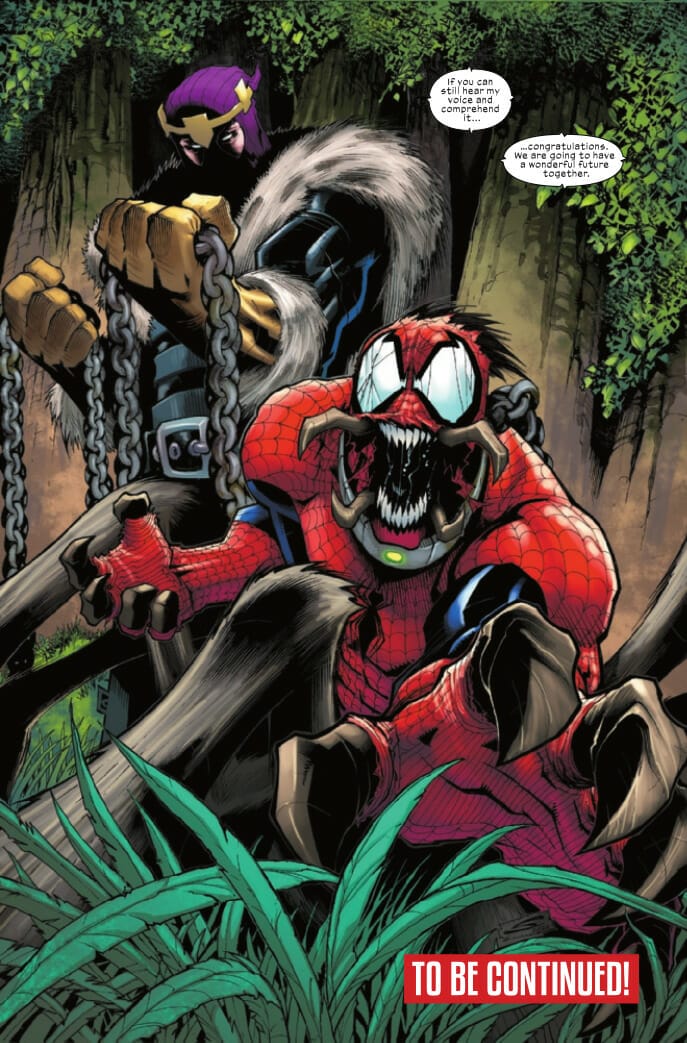
Whilst continuing an intriguing and quirky premise for a Spider-Man book, the focus on making the issue almost entirely action-based made it so the story took a back seat. This issue saw a minimal exploration of our titular character, with it even being brought back in some areas, namely any discussion of how he is able to see into Wülf’s memories.
However, this issue is a treat for the eyes, offering that familiar flair and vibrancy as seen in Spider-Man comics throughout the 1990s. The pencils and colors of Gerardo Sandoval and Chris Sotomayor remain a highlight of this series. Although there is a concerning amount of splash pages throughout the book, they present dynamic and fluid action set pieces that allow the issue to stay fast-paced and hard-hitting. It is an unfortunate side-effect that any single page doesn’t hold up the same sense of motion and depth.
The sticking point for this issue is the political nature of Immacultam’s mission and design. A presentation of a diverse group of revolutionaries as just as dangerous as extremist fascist groups presents an unfair and uneducated display of the differences between these extremes of the political spectrum. Although this idea of some hidden political message is most likely baseless, any truth within this idea deserves to be raised for discussion.
Savage Spider-Man Issue Two is a strange issue. Although perfectly serviceable and fun, there may be certain elements that will leave this book lingering at the back of some reader’s mind. Regardless of what possible political discussion may or may not surround this comic, it is a fun, action-packed continuation of the previous issue which falls into the unfortunate trope of prioritizing action rather than a continuation of this story.
Hopefully, issue three can amend this disparity between the action and story and give readers something to sink their teeth into whilst having some marvelous visuals to feast on.
Want to discuss things further? Hit us up on Twitter, Facebook, or Instagram. For more film, gaming, anime, and comic book content; TV news, trailers, updates, and reviews, make sure to keep it locked right here at The Nerdy Basement. While you’re here, please consider supporting us on Patreon! It’s an easy way of supporting us so we can keep providing you with your Nerdy News!

